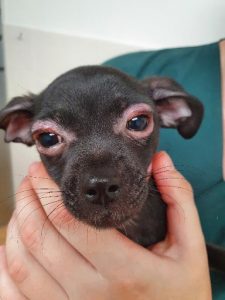All dermatological diseases are diagnosed and treated at the clinic. The clinic will perform diagnostics, laboratory tests and apply the necessary treatment to cure the pet's problem.
The skin is the largest organ, and skin conditions are most common in pets, itching is the main complaint. Therefore, in order for a pet to be able to live a quality life, it is necessary to consult a veterinarian in case of dermatological symptoms (itching, scaling of the skin, rash, etc.).
The most common dermatological diseases:
Bacterial skin diseases (pyoderma)
Pyoderma (purulent bacterial inflammation of the skin) is an infectious disease of the skin caused by pathogenic bacteria.

Skin wrinkle dermatitis
Wrinkle dermatitis is most common in breeds such as the English Bulldog, French Bulldog, Shar Pei, Spaniel. Wrinkle dermatitis can form on the lips, vulva and mouth.

Furunculosis
Furunculosis is a deep purulent inflammation of the hair follicle, adjacent sebaceous glands and other surrounding tissues. The deeper layers of the skin are damaged during this inflammation.

Pododermatitis
It is an inflammation of the skin in the area of the feet and toes. Breeds prone to this disease – English Bulldogs, Cocker Spaniels, French Bulldogs, Labradors and Golden Retrievers, etc.

Juvenile cellulite
Detected in young puppies, often mixed with an allergic reaction. Occurs in the foot area (lips, eyelids, ears).

Fungal diseases
Dermatophytosis – baldness, round itchy spots, erythema. Mostly located in the head and limb areas.
Malasal dermatitis – symptoms such as erythema, abrasions, itching are visible. Severe itching is the main sign, together with unpleasant odor.
Parasitic skin diseases
The main parasitic diseases of pets:
- Subcutaneous ticks
- Flea allergic dermatitis
- Cheyletiella spp. ticks – “walking on dandruff”
- Dog lice

Atopic dermatitis
It is an allergic reaction of the body to allergens that come directly on the skin or inhaling them with air. It is the second most common allergic disease, surpassed only by flea-induced allergic dermatitis. Atopic dermatitis is most commonly seen in animals aged 1 to 3 years. If exacerbations are in winter, it may be due to dust mites.

Dog food allergy
An adverse food reaction refers to an abnormal clinical response associated with the consumption of food or food additives. The reaction can be like food allergy or food intolerance. Symptoms may be linked with skin and / or gastrointestinal tract (pruritus, erythema, alopecia, otitis, diarrhea, flatulence, frequent bowel movements).

VIKTORIJA TVARANAVIČIŪTĖ
VeterinarianViktorija Tvaranavičiūtė, a veterinarian working in the field of dermatology, who is constantly improving her knowledge in this field, will help diagnose and cure your pet's dermatological disease.